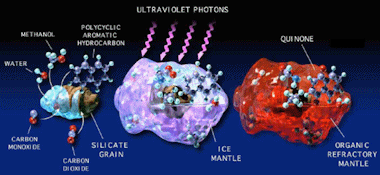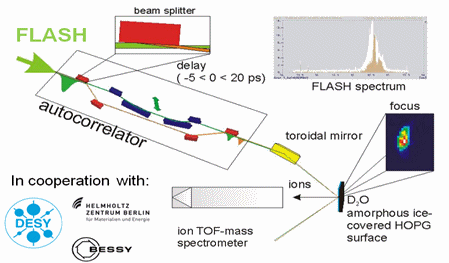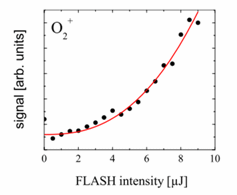
Investigation of UV/XUV-laser-induced photochemical reactions in ice
To understand interstellar chemistry and the initial steps of star formation, fundamental data on surface and bulk reactions on interstellar grains are necessary. In regions of the universe huge clouds of dust particles can be found, which are active components of the interstellar circuit. They consist of cores of silicates and carbonaceous material and are embedded in icy mantles doped with several molecules such as carbon monoxide (CO), carbon dioxide (CO2), methanol (CH3OH) and different compounds of PAHs (polycyclic aromatic hydrocarbons). In the cores of dark clouds mostly thermal reactions at ultralow temperatures of about 10 K proceed. However, in the outer regions also radiative interactions may occur.

At present it is an open question what kinds of reactions are triggered when light from newborn, hot stars impinges on the ice-covered interstellar dust grains.
In our laboratory we use temperature programmed desorption (TPD) to investigate the binding energies of relevant molecules for different coverages on model substrates such as HOPG (highly ordered pyrolytic graphite) or Olivine ((Mg, Fe)2 SiO4, a solid solution) as an analogue for interstellar dust particle cores. These are placed on a helium cryostat to provide low temperatures down to 8 Kelvin.
We have also already studied the light-induced desorption of atomic hydrogen from HOPG and also observed photochemical reactions in ice surfaces of D2O on HOPG due to XUV radiation at FLASH in Hamburg.

Molecular oxygen ions detected by a mass spectrometer indicate a non-linear dependence on the FLASH intensity, thus enabling XUV pump and XUV probe experiments to analyze the desorption mechanism and the formation pathways of complex molecules on and within ice-covered surfaces.
The results of these experiments will provide a more detailed insight into the initial stages of star formation and the potential for the development of biologically relevant molecules in ice-covered surfaces due to UV as well as XUV radiation.
The project participates in the European-wide ITN network LASSIE
(Laboratory Astrochemical Surface Science in Europe).
Literature
Frigge et al., Phys. Rev. Lett. 104, 256102 (2010)
Siemer et al., Chem. Phys. Lett. 500, 291 (2010)
Siemer et al., J. Phys.: Condens. Matter 22, 084013 (2010)
Siemer et al., J. Phys. Chem. A 115, 7356 (2011)



